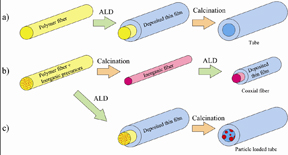| Santala, et.al., report a versatile method for preparing magnetic and photocatalytic nanofibers by combining electrospinning and atomic layer deposition (ALD) to control both the materials composition of the nanofiber and the specific structure and dimensions of the resulting fibers. |
A review by Jeff Morse, Ph.D., National Nanomanufacturing Network
- Santala, E., Kemell, M. Leskela, M., and Ritala, M. "The preparation of reusable magnetic and photocatalytic composite nanofibers by electrospinning and atomic layer deposition." Nanotechnology 20 (2009) 5pp. DOI: 10.1088/0957-4484/20/3/035602
Magnetic composites in the form of nanoparticles and nanofibers have attracted significant attention recently for potential applications including electrochemical biosensing, bioseparation, the detection of DNA, RNA, cells and proteins, and controlled drug and gene delivery. Magnetic nanopowders are tradionally prepared using co-precipitation, thermal decomposition, microemulsion, and hydrothermal synthesis techniques; magnetic nanofibers are traditionally prepared by electrospinning. While these techniques are suitable for preparing materials with specific structural and compositional parameters, they tend to be limited in the control of composite material, along with the range of specific structures that can be achieved.

Electrospinning of nanofibers is a mature process that uses high voltage to create fiber structures from a polymer solution flowing through a nozzle at relatively high velocity. ALD enables atomically precise thin films to be conformally coated over three-dimensional structures. The range of materials that can be deposited includes many metal oxides and metals, and depends on available precursors. In the work described here, magnetic core and non-magnetic shell composite structures were explored. Specifically, magnetic nanofiber compositions were prepared by mixing precursor solutions of NiFe2O4 or CoFe2O4 with polyvinyl pyrrolidone (PPV) dissolved in ethanol. Composite nanofibers 200 nm in diameter were created. ALD was then used to conformally coat the nanofiber with a layer of TiO2 thereby forming the outer shell.
The versatility of this process renders it suitable for nanomanufacturing of a range of controlled materials compositions and structures. Nanotubes can be synthesized by using ALD to coat polymer nanofibers, then removing the fiber material through a calcination step. For composite nanofibers, after the ALD coating is applied, the subsequent calcination step results in a nanotube that is loaded with the inorganic particles from the nanofiber composition. Conversely, the process steps can be arranged so that the composite nanofiber is first calcined to form an inorganic nanowire or nanofiber, after which ALD coating forms a coaxial structure having specific core and shell materials.
Scale-up nanomanufacturing issues should be feasible as these techniques and tools are already used in manufacturing environments for various technologies, including semiconductors and textiles. The only limitation for the process sequence is the stability of the materials properties during high temperature process steps, a factor that was cited in this work. Another key point elucidated by the authors is the use of magnetic materials incorporated into the structure enabling recovery of the structure after use by magnetic separation, something to enable environmentally friendly or reusable materials. This latter point is even more critical for recovering precious or toxic materials.
Image from Santala, E., et.al, "The preparation of reusable magnetic and photocatalytic composite nanofibers by electrospinning and atomic layer deposition." Nanotechnology 20 (2009) 5pp. Reproduced with permission.
This work is licensed under a Creative Commons Attribution-NonCommercial-NoDerivs 3.0 Unported.
